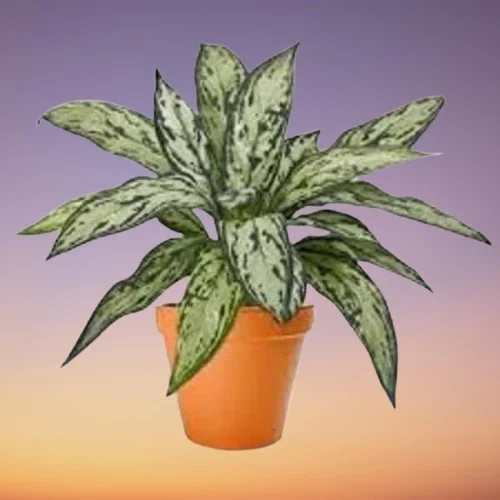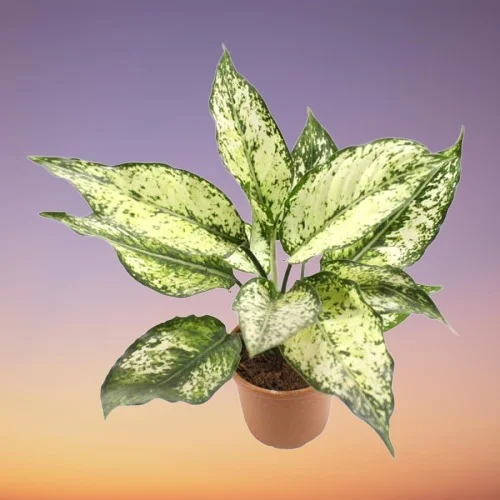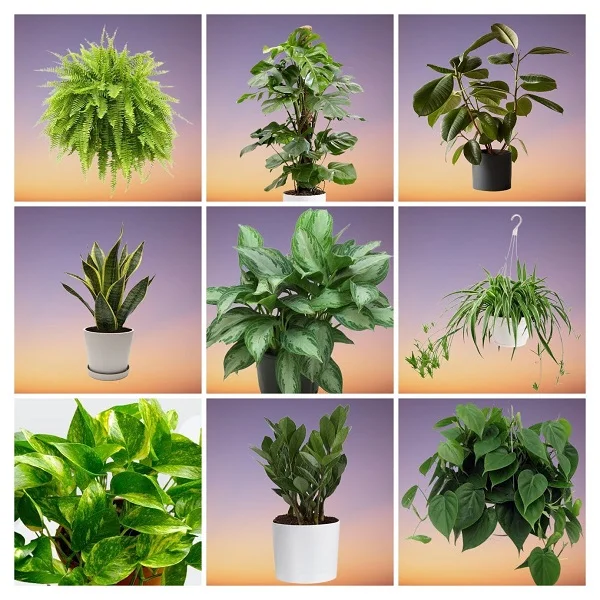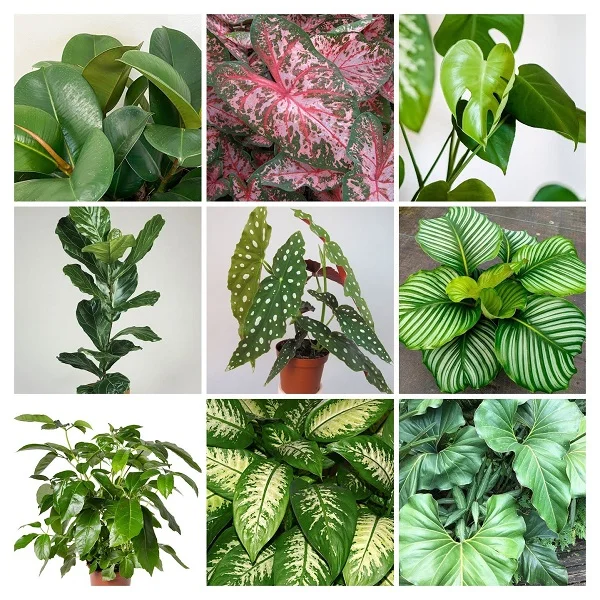Chinese Evergreens (Aglaonema) Care Indoors, Propagation, Problems and Solutions
Some links in this post may be affiliate links
Chinese Evergreens (Aglaonema) flourish in medium to bright indirect light, average warmth, moderate humidity and moderately moist, well-drained soils that are rich in organic matter.
Aglaonemas are some of the popular tropical foliage plants on account of their spectacular foliage, ease of care, air cleaning properties and ability to adapt to a wide range of growing conditions.
Chinese Evergreens are relatively small and exhibit a compact growth. The leaves are large, spear-shaped and borne on short stems and have a strong vein running down the middle and a speckled pattern along the sides.
Being slow growers, Aglaonemas are great plants for limited spaces, this coupled with their air cleaning abilities make Chinese Evergreens some of the best plants for a study table.
Aglaonemas, especially the all green varities, are very tolerant to low light or shade conditions and are among the best plants for low light spaces in the home.

Botanical name: Aglaonema
Family: Araceae
Common name: Chinese Evergreen
Origin
Aglaonemas are native to tropical and subtropical regions of Asia and New Guinea.
Flower
The inflorescence in Chinese Evergreens are unimpressive unisexual flowers in a spadix. To conserve the plants energy and direct it to foliage growth, cut the flowers as soon as they appear though it is unlikely to flower when grown indoors.
Varieties
There are numerous Aglaonema varieties and hybrids available for home growing. It is the green varieties Aglaonema modestum that can tolerate some shade but the near-white varieties need a well-lit environment.
The favorite of the group is the Aglaonema silver queen whose foliage is almost entirely silver-grey
Another common variety of Aglaonema is the Aglaonema pseudobracteatum (Golden Evergreen) whose leaves are blotched with yellow, cream and pale green.
Other varieties are Aglaonema commutatum whose leaves have silver bands, Aglaonema nitidum which is the giant of the group with leaves 18 inches plain green and Aglaonema pictum whose 6 inches long leaves are speckled and velvety among many varieties and hybrids.
Do Aglaonema purify the air?
According to the NASA Clean Air Study, Aglaonema modestum was found to be among the best air-purifying plants effective in the removal of benzene and formaldehyde from indoor air.Are Aglaonema toxic?
Yes. Aglaonema are toxic to both humans and pets as indicated by ASPCA. The plant sap contains calcium oxalate crystals which can cause irritation on sensitive skin; always wear gloves when handling Chinese Evergreens. If ingested, the plant sap can cause burning in the mouth and throat, vomiting, diarrhea and abdominal pains.
Where to Buy
If you would like to add Aglaonemas to your plant collection, they are available online on Amazon (Link to Amazon).
How to care for Chinese Evergreen indoors
To care for Chinese Evergreens indoors, provide medium to bright indirect light, average warmth of 18-270C, humidity of 50-55% and moderately moist, well-drained soils that are rich in organic matter coupled with feeding every 3-4 months in the growing season.
Aglaonemas are slow-growing plants which do not require regular repotting. Grooming is needed to keep the plant neat and minimize pests and diseases infestations. Keep reading for more on these growing conditions and how to achieve them.

Light Requirements
How much light does a Chinese Evergreen need?
Chinese Evergreens grow best in semi-shade to bright light conditions (medium to bright indirect light). Keep them away from direct sunlight as it can cause scorching on the leaves.
The near-white variegated plants require more brighter light than the more green varieties. Where natural lighting is not sufficient, you may instal grow lights to supplement it.
Keep rotating the pot at regular intervals to ensure that the plant receives light on all sides for uniform growth.
Watering
How often do you water a Chinese Evergreen?
Chinese Evergreens require to be watered liberally in spring and summer while allowing the top 2 inches of soil to dry out slightly between waterings. Maintain the soil moderately moist and avoid overwatering to prevent rotting, yellowing and leaf loss.
Cut down on watering in fall and winter as growth is minimal at this time but do not allow the soil to dry out completely as it may cause wilting and leaf drop.
Use chlorine-free water like rain water or filtered water to prevent brown leaf stains. Ensure that the water is at room temperature to avoid cold shock which can result in stunted growth and leaf fall.
Confirm that the pot has a drainage hole and the soil is well-draining to prevent waterlogging as it can lead to root-rot and death of the plant.
Temperature and Humidity
Chinese Evergreens thrive in an average warmth of 18-270C. Below this temperature the plant may stop growing and die. Keep the plants away from cold drafts as they are intolerant to very low temperatures below 150C which may cause the leaves to curl and develop brown edges.
Aglaonemas require a moderate humidity of 50-55%. They have no need for extra humidity. However, too dry air may lead to brown leaf tips and edges. Therefore, to increase humidity, group the plants together, use a humidifier or set the pot on a wet pebble tray.
Feeding
What to feed a Chinese Evergreen?
Feed your Chinese Evergreen with a liquid fertilizer (foliar feed) every 3-4 months in spring and summer. It is not a heavy feeder.
To prevent the leaves from turning yellow due to copper deficiency, ensure your fertilizer contains this micronutrient. Aglaonema is easily injured by overfeeding therefore withhold feeding in fall and winter as growth is minimal and feeding at this time can lead to fertilizer burn.
Potting Soil
What kind of soil do Chinese Evergreens like?
Chinese Evergreens like a loose, free-draining soil that is rich in organic matter to prevent it from getting soggy while providing the required nutrients. Most potting mixes designed for indoor plants are ideal for these plants.
Repotting
Chinese Evergreens are slow-growing thus do not require very frequent repotting. Repotting may be necessary after 2-3 years when the plant has outgrown its current pot or the soil needs to be replaced.
The best time to repot Aglaonemas is at the beginning of the growing season (spring to early summer). Use a free-draining soil that is rich in organic matter and a pot 1 size larger than the current one.
Ensure the pot has a drainage hole to prevent the soil from getting soggy as it can lead to rotting. Take a look at these pots with drainage holes on Amazon.
Pruning & Grooming
Being a slow grower, Chinese Evergreen requires minimal pruning. Pruning Aglaonema involves removal of yellow and old leaves by cutting them at the soil level.
Remove the inflorescences that may develop to prevent the plant from wasting energy to develop the inflorescences to prolong the life of the plant.
Regularly clean the leaves by damp-wiping with a soft cloth to get rid of dust and reduce pest infestation.
How to make Chinese Evergreen bushier?
Trim the stems down to about 2 inches above the soil; this will encourage new stems to sprout at a spot below the cut. Use the old leggy stems to propagate new plants.
Chinese Evergreen Propagation
Chinese Evergreen is propagated from stem cuttings or by plant division. The best time to propagate Aglaonema is at the beginning of the growing season when it is in the active growth phase.
Learn more on how to propagate Chinese Evergreens (Aglaonema propagation).

Chinese Evergreen Problems & Solutions
Aglaonema problems include yellow leaves, plant dying, brown and dry leaf spots, curled and crispy leaves, brown leaf tips and edges, diseases and pests. Keep reading for more on these problems and how to fix them.
Yellow leaves
Why are the leaves on my Chinese Evergreen turning yellow?
Some of the causes of yellow leaves on your Chinese Evergreen are aging, inconsistent watering, soggy soil, too little light, nutrient deficiency or temperature stress. To keep the plant neat and tidy, cut away the yellow leaves at the soil level.
How to fix it
Aging: With age, the lower leaves turn yellow and die. These leaves are replaced by new leaves at the top of the plant.
Inconsistent watering: Water when the top 2 inches of soil to dry out. Never allow the soil to dry out completely.
Soggy soil: Use a pot that has a drainage hole and free-draining soil.
Too little light: Position the plant to a brighter spot where it will receive medium to bright indirect light or instal a grow light if the natural lighting is not sufficient.
Nutrients deficiency: Apply a balanced, water-soluble fertilizer every 3-4 months in spring and summer.
Temperature stress: Keep the plant away from drafts emanating from hot surfaces, hot air vents, AC units, windy doors among others.
Plant dying
Why is my Chinese Evergreen dying?
Your Chinese Evergreen may be dying due to root-rot or from root-knot nematodes infestation.
How to fix it
Root-rot disease which is a fungal disease and is prevalent in soggy soil due to poor soil drainage.
- Slip the plant out of its pot, wash off the soil and inspect the roots.
- Brown-black, mushy roots indicate root-rot; cut them away. In addition, cut away any stems showing any signs of rot.
- Disinfect the healthy roots and the entire plant with a copper-based fungicidal solution as indicated by the manufacturer.
- Disinfect the pot with the fungicidal solution or use a fresh pot to repot the plant in fresh potting soil.
- Ensure that the pot has a drainage hole and the soil is well-draining to prevent waterlogging.
- Water the plant with the fungicidal solution and place it in a warm, brightly-lit spot.
- Do not water the plant again until new growth appears and avoid overwatering and soggy soil thereafter.
Root-knot nematodes infestation is marked by swellings in the roots of the plant.
- There is no chemical control for the Nematodes; destroy the plant immediately by burning.
- Use only sterilized soil in the future; nematodes can last in contaminated soil for a long time.
- Source your plants from reputable suppliers only, to avoid plants that may be infested by Nematodes.
Brown, dry leaf spots
Brown leaf spots on Chinese Evergreen are a sign of sunscorch marks due to exposing the plant to direct sunlight.
How to fix it
Position the plant where it will receive bright filtered light; a spot infront of a brightly lit window that has a screen like a sheer curtain.
Curled leaves and brown leaf edges
Curled leaves and brown leaf edges on Chinese Evergreen are caused by cold air from drafts.
How to fix it
Keep the plant away from cold drafts to to maintain constantly warm temperatures.
Shrivelled leaves and brown leaf tips
Shrivelled leaves and brown leaf tips on Chinese Evergreen are caused by too dry air (low humidity).
How to fix it
Group the plants together, set the pot on a wet pebble tray or use a cool mist humidifier to eleavte humidity.
You may also grow the plant in a well-lit bathroom, kitchen, laundry area and other moist areas in the home.
Diseases
Chinese Evergreen is also prone leaf spot disease which is characterized by brown, soft leaf spots. It is enhanced by overwet conditions coupled with poor air circulation.
How to fix it
- Remove and burn the affected parts to reduce the risk of spread to the rest of the plants.
- Spray the affected plant with a systemic fungicide as indicated by the manufacturer. Ensure all the parts are completely covered with the fungicidal solution.
- Improve on ventilation to ensure that there is free air circulation at all times.
Pests
Common pests on Chinese Evergreen are mealybugs, scales, aphids and spider mites.
How to fix it
- Isolate the affected plant to prevent spread to the other plants.
- Treat the plant with neem oil or an insecticidal soap. Ensure to follow the manufacturers' instructions on the label.
- Maintain the plant well pruned to discourage the pests.
- Set the pot on a wet pebble tray or group the plants together to increase humidity to minimize the pests infestations.
You liked it? Share on social media.
Related Content
Amazon Associates Disclosure
Homeplantsguide.com is a participant in the Amazon Services LLC Associates Program, an affiliate advertising program designed to provide a means for sites to earn advertising fees by advertising and linking to amazon.com.





